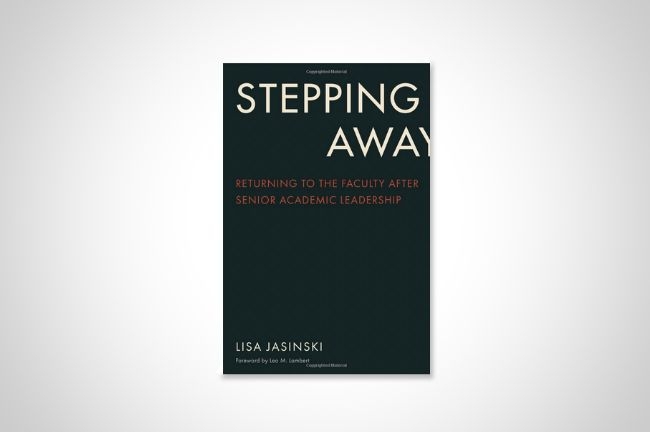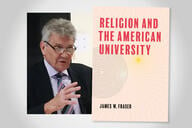You have /5 articles left.
Sign up for a free account or log in.

Rutgers University Press
In Stepping Away: Returning to the Faculty After Senior Academic Leadership (Rutgers University Press), Lisa Jasinski considers the role of former presidents, provosts and others who return to the faculty. She notes that in no other profession is it common for people who are leading the organization to return to the rank and file.
Jasinski is the senior director of strategic initiatives in the Office of the President at the University of Texas at San Antonio. Her new book is based on interviews with senior college administrators who have rejoined faculty rolls and with faculty members who have dealt with a new colleague arriving from the top of the hierarchy. Her book covers seemingly small details (like what to wear) and larger ones, such as pay.
She responded to questions about the book via email.
Q: You suggest that ex-administrators dress more informally and “let it go.” Why are these kinds of moves important?
A: At its core, I argue that the process of stepping away from academic leadership and reprising a full-time faculty role is one of identity reformulation. So much of this reformulation happens internally—ex-administrators shift how they see themselves and use their time. While the effect is transformative, these changes are often invisible.
External markers are helpful signifiers of change for both leaders and their campuses. It takes time for everyone to adjust after a transition. Ex-leaders can help this process along in various ways: dressing casually, prefacing their comments by saying, “I’m no longer speaking as a dean …” or “wearing my faculty hat, I think …” or sitting at the back of the room rather than the head of the table. These actions remind others that things are different. Verbal and visual cues can also aid ex-administrators in remembering that they occupy a new place in the social architecture (just in case they lapse into administrator mode). These symbolic changes are critical to establishing a new social order.
Q: You also discuss offices. Can a president truly return to the faculty without having an office “among the people”?
A: Much in the way that dressing casually cements a former president’s new role and status, occupying a humbler workspace is also a powerful reminder. There are many advantages to working alongside your colleagues in a traditional faculty office. Being closer to faculty peers and students can aid an ex-president in forging new relationships. Proximity and accessibility signal an ex-leader’s desire to be part of the departmental community.
In my research, I learned there is no one way to return to the faculty. The professional activities of ex-administrators can vary significantly. One person might rev up their research, while another will cease publishing to focus on teaching. Depending on these factors, it may not be practical or advisable for a former president or provost to take up an office near faculty peers. Sometimes, no open office may be available in the departmental suite. Leaders who experience a particularly hostile exit (e.g., a vote of no confidence) or those who may take on a more singular focus (e.g., fundraising, alumni engagement) might find an office located on the periphery of campus to be a better fit. While the workspace should fit an individual’s needs and goals, all leaders returning to the faculty should remember that the community takes notice. Sequestering oneself away from colleagues will be read as a desire to return to the faculty in name only.
Q: You discuss the issues involved in re-entering an academic department. What kinds of things work for an ex-administrator?
A: Former leaders are wise to recognize that their mere presence shifts workplace dynamics. Ex-leaders should be extra sensitive to how others might perceive their words and actions. Asking a pointed question in a department meeting may be misinterpreted as undercutting the chair’s authority. Given the lingering power differentials, department colleagues might feel sheepish about inviting their former boss for coffee or lunch. It is incumbent on an ex-leader to break the ice and forge meaningful connections with others.
One of the best ways to demonstrate humility is by asking for help. Your new colleagues are a great resource, and asking them to share what they know will go a long way in enabling them to see you as a true peer rather than the all-powerful decider in chief. In recent years, the practice of reverse mentoring—when an experienced leader takes on younger advisers—has gained traction in the business world. I think this model holds promise in academia. Not only are assistant and associate professors conversant in the latest scholarship in the field, but they are sure to have fresh perspectives on utilizing classroom technologies and engaging meaningfully with Gen Z students.
While an ex-administrator might have a long tenure at an institution, I found that they benefit from many onboarding activities designed for new hires (e.g., how to place a textbook order). Leaders shouldn’t be afraid to show some vulnerability by asking their chair to take them through an orientation or to ask for support in restarting their teaching and research—especially if they have been away from these activities for a decade or more.
Q: Toward the end of the book, you write, “colleges and universities have a structural problem: many are paying their former presidents and provosts too much upon returning to the faculty.” How should they be paid?
A: Within higher education, there is no standard model for how former presidents and provosts are paid upon returning to the faculty; terms vary considerably across states and institutions. James Finkelstein and Judith Wilde have done some illuminating research on executive contracts, finding that many top administrators are guaranteed lucrative “platinum parachutes” upon returning to the faculty. In some models, returning leaders are guaranteed their full administrative salaries (or one that is prorated to reflect having summers off). I find this practice costly, unsustainable and, ultimately, unnecessary. Having interviewed more than 50 former senior academic leaders, many return to the faculty for the inherent intellectual rewards, not because of the paycheck.
To address this structural problem, I propose a pay structure that seeks to treat former leaders fairly while allowing universities to direct resources toward mission-critical activities. Upon stepping away, a leader should be awarded a paid sabbatical leave at the rate of 9/12th of their annual administrative salary (reflecting an academic-year appointment), a common practice in the status quo.
And then, upon resuming full-time faculty duties, ex-leaders should be paid an annual salary at a rate that is the average of others in the department at the equivalent rank. Effectively, this means that some disciplinary salaries may be higher than others, but this is already the case at most institutions. If a former administrator’s record justifies it, they might be named to a distinguished chair or receive some one-time start-up funds to revive their research program. But otherwise, the board should not entertain additional perks. Even for well-resourced institutions, keeping two or three presidents on the payroll in perpetuity can quickly add up to hundreds of thousands of dollars, if not more.
When former academic leaders return to the faculty, it’s only fair that they get paid like professors.
Q: These days, more and more presidents come without a faculty background, as political and business leaders go for presidencies. Do the issues in your book apply to them?
A: While I wrote the book as a helpful primer for leaders who return to the faculty, leaders from all backgrounds can benefit from the findings.
So-called nontraditional presidents will gain valuable insights, such as how best to engage with the former president (if at all) or how to compensate deans and provosts who return to the faculty. In the book, I demonstrate how leaders who return to the faculty are poised to add value to their institutions in many ways. Leaders from the business world or other fields will benefit greatly from this understanding and identify how best to empower these potential assets.
I’ve also included sections directed at trustees and governing boards. Acquiring a nuanced, empirically informed perspective on why leaders return to the faculty and the pain points they experience will better position overseers to govern their universities well.




